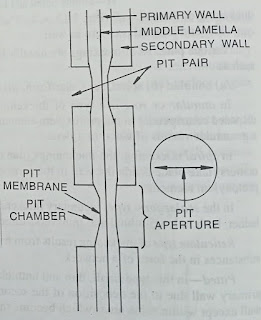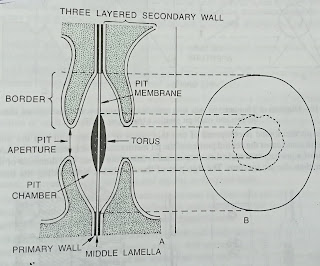As the cell grows, the primary walls of the young cells stretch and increase in the surface area and thickness. These stretched primary walls are generally not of uniform thickness but have conspicuous thin depressions in them at intervals, these are called primary pit fields. When pit-fields are numerous and deeply sunken, the wall in which they occur appears to be beaded in transverse section. One of the characteristic features of the primary pit-fields of living cells is the presence of plasmodesmata, although they occur also in other regions of the wall.
Secondary walls also have cavities due to the uneven deposition of secondary cell wall materials.
Such cavities, which are of variable shape, are called pits. It is to be noted that thin depressions i.e. primary pit-fields in primary walls differ from the pits in secondary walls in structure and development. The primary walls have primary pit-fields, whereas the secondary walls have pits. Primary pitfields are found in meristematic cells and those of their derivatives that have no secondary walls. The adjective pitted is applied either to secondary walls having pits or to primary walls having primary pit-fields.
Pits also vary in size and number. In front view, they look round, oval or pentagonal in shape. Through these perforations, materials pass from one cell to another cell. Pits may develop over the primary pit-fields and then one or more pits may occur in the pit-fields, or pits develop those parts of the primary wall devoid of pit-fields.
Usually the pits are formed in pairs, i.e. when a pit is present on the secondary wall of one cell, a similar pit will be present on the opposite side of the adjacent cell-such pits form a morphological and functional unit called pit-pair. In some cases blind pits are formed i.e, a solitary pit is formed on the wall without having any similar pit on the corresponding adjacent wall. Semetimes two or more pits may develop opposite to one large pit-such an arrangement IS called unilateral compound pitting.
 |
| Diagram showing the structure of simple pits arranged in pit pair. |
Fundamentally a pit or pit-pair consists of three parts, viz.
(a) Pit cavity or Pit chamber-the space i.e. the cavity formed by the break in the secondary wall is called pit chamber.
(b) Pit aperture- the opening of the pit cavity on the inner side of the cell wall is called pit aperture.
(c) Pit membrane or Closing membrane-It is the thin wall composed of the layers of primary cell wall together with the middle lamella between two adjacently lying cells.
Types of pits-Two main types of pits are recognised in cells with secondary walls, such as simple pits and bordered pits.
A. SIMPLE PITS -These are round or oval thin areas in front view. The diameter of the pit cavity is equal throughout its entire depth, or it may be wider or narrower. towards the pit aperture ; when the pit cavity becomes narrower towards the pit aperture, the simple pit approaches the structure typical of a bordered pit. The thickened side walls (of the secondary wall) lie at right angles to the pit membrane. No border or rim is found over the Simple pits as the secondary wall does not arch over the pit cavity. In places where the secondary wall is very thick, the pit cavity has the form of a canal. Simple pits are found in libriform fibres, sclereids, xylem parenchyma, ordinary parenchyma cells and vessels.
 |
| Diagram showing the structure of a bordered pit pair in sectional and surface views. |
B. BORDERED PITS -Bordered pits are more complex and more variable in structure than simple pits. In this type, pits are provided with a rim or border ; the seconda wall develops over the pit cavity i.e. pit chamber to form an over arching roof (pit border) with a narrow pore (pit aperture) in its centre. The pit aperture may be circular, lenticular or linear. If the secondary wall is very thick, a canal called the pit canal is formed between the cell lumen and the pit chamber. Then two openings are distinguished in the pit canal such as (i) inner aperture which lies towards the cell lumen and (ii) outer aperture Which lies towards the cell wall.
Hence a bordered pit appears like two circles in surface or from view. As the pit aperture forms a border round the pit chamber, hence the name bordered pit. The pit membrane is composed of two thin layers of primary wall and the middle lamella. In some cases the central portion of the pit membrane is thickened ; this thickening which is of a primary nature, is disc-shaped and is called the torus. The diameter of torus is larger than the pit aperture. The thin part of the membrane surrounding the torus is called margo (Frey-Wyssling, 1959). The pit-membrane is nexible and under certain conditions the torus occurs in a lateral position, appressed to one or the other pit aperture of the pit-pair-such a pit-pair is termed aspirated pit-pair. Bordered pits generally occur in the elements of xylem, e.g. vessels, tracheids, fibres etc. They may be found in some fibres and sclereids outside the xylem also. If two pits of a pair are simple, it is called a simple pit-pair ; if two pits are bordered, it is termed a bordered pit-pair.
Sometimes, a type in between simple and bordered pit, known as a half-borderedpitair occurs. Here combination ofa simple and a bordered pit is seen, i.e. a simple pit on one side is associated with one bordered pit on the opposite side. In this type torus is either absent or poorly developed.
 |
| Diagram of a bordered pit pair with extended pit apertures, flattened canals, reduced borders and small pit cavities. |
VESTURED PITS- These are the special type of pits named by Bailey (1913). In some dicotyledons thin, minute, simple or branched sculpturings are present on the secondary wall of the pit chamber or along the edges of the pit apertures.
These sculpturings forming the vestures (i.e. minute outgrowths) are of several types, e.g. papillose, filamentous, coralloid etc. Only bordered pits are vestured while in half-bordered pits only the bordered side of the pit-pairs is vestured. Vestured pits are found in the tracheary elements of the secondary wood of some dicotyledonous families like Cruciferae, Myrtaceae, Leguminosae, Caprifoliaceae etc.
 |
| Aspirated pit pair and vessels with vestured pits in longitudinal section. |
Vestured pits are found in phylogenetically more developed xylem, hence vestured pits are considered as an advanced type of pit.




Comments
Post a Comment